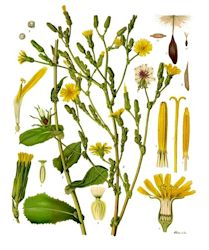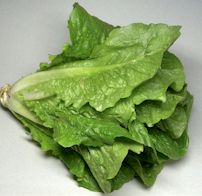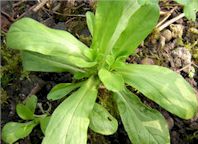|

Wild Lettuce |
Our garden Lettuce is a cultivated variety of the wild, or strong-scented Lettuce (Lactuca virosa), which grows, with prickly leaves, on banks and waysides in chalky districts throughout England and Wales. It belongs to the Composite order of plants, and contains the medicinal properties of the plant more actively than does the Lettuce produced for the kitchen. An older form of the name is "Lettouce", which is still retained in Scotland.
Chemically the wild Lettuce contains lactucin, lactucopricin, asparagin, mannite, albumen, gum, and resin, together with oxalic, malic, and citric acids; thus possessing virtues for easing pain, and inducing sleep. The cultivated Lettuce which comes to our tables retains these same properties, but in a very modified degree, since the formidable principles have become as completely toned down and guileless in the garden |
product as were the child-like manners and the pensive smile of Bret Harte's Heathen Chinee.
Each plant derives its name, lactuca, from its milky juice; in Latin lactis; and in Greek, galaktos (taking the genitive case). This juice, when withdrawn from the cut or incised stalks and stems of the wild Lettuce, is milky at first, and afterwards becomes brown, like opium, being then known (when dried into a kind of gum) as lactucarium. From three to eight grains of this gum, if taken at bedtime, will allay the wakefulness which follows
over-excitement of brain. A similar lactucarium, got from the dried milk of the cultivated garden Lettuce, is so mild a sedative as to be suitable for restless infants; and two grains thereof may be safely given to a young child for soothing it to sleep.
The wild Lettuce is rather laxative; with which view a decoction of the leaves is sometimes taken as a drink to remedy constipation, and intestinal difficulties, as also to allay feverish pains. The plant was mentioned as acting thus in an epigram by Martial (Libr. VI., Sq.).
"Prima tibi dabitur ventro lactuca movendo Utilis, et porris fila resecta suis."
Gerard said: "Being in some degree laxative and aperient, the cultivated Lettuce is very proper for hot bilious dispositions;" and Parkinson adds (1640): "Lettuce eaten raw or boyled, helpeth to loosen the belly, and the boyled more than the raw." It was known as the "Milk Plant" to Dioscorides and Theophrastus, and was much esteemed by the Romans to be eaten after a debauch of wine, or as a sedative for inducing sleep. But a prejudice against it was entertained for a time as
venerem enervans, and therefore mortuorum cibi, "food for the dead."
Apuleius says, that when the eagle desires to fly to a great height, and to get a clear view of the extensive prospect below him, he first plucks a leaf of the wild Lettuce and touches his eyes with the juice thereof, by which means he obtains the widest perspicuity of vision. "Dicunt aquilam quum in altum volare voluerit ut prospiciat rerum naturas lactucoe sylvaticoe folium evellere et succo ejus sibi oculos tangere, et maximam inde claritudinem accipere."
After the death of Adonis, Venus is related to have thrown herself on a bed of lettuces to assuage her grief. "In lactuc?ccultatum a Venere Adonin--cecinit Callimachus--quod allegoric?nterpretatus Athenoeus illuc referendum putat quod in venerem hebetiores fiunt lactucas vescentes assidue."
The Pythagoreans called this plant "the Eunuch"; and there is a saying in Surrey, "O'er much Lettuce in the garden will stop a young wife's bearing." During the middle ages it was thought an evil spirit lurked among the Lettuces adverse to mothers, and causing grievous ills to new-born infants.
|

Roman Lettuce |
The Romans, in the reign of Domitian, had the lettuce prepared with eggs, and served with the last course at their tables, so as to stimulate their appetites afresh. Martial wonders that it had since then become customary to take it rather at the beginning of the meal:
"Claudere quae caenas lactuca solebat avorum Dic mihi cur nostras inchoat illa dapes."
Antoninus Musa cured Caesar Augustus of hypochondriasis by means of this plant. |
The most common variety of the wild Lettuce, improved by frequent cultivation, is the Cabbage Lettuce, or Roman, "which is the best to boil, stew, or put into hodge-podge." Different sorts of the Cos Lettuce follow next onwards. The Lactuca sylvatica is a variety of the wild Lettuce producing similar effects. From this a medicinal tincture (H.) is prepared, and an extract from the flowering herb is given in doses of from five to fifteen grains. No attempt was made to
cultivate the Lettuce in this country until the fourth year of Elizabeth's reign.
When bleached by gardeners the lettuce becomes tender, sweet, and succulent, being easily digested, even by dyspeptic persons, as to its crisp, leafy parts, but not its hard stalk. It now contains but little nutriment of any sort, but supplies some mineral salts, especially nitre. In the stem there still lingers a small quantity of the sleep-inducing principle, "lactucarin," particularly when the plant is flowering. Galen, when sleepless from advanced age and infirmities,
with hard study, took decoction of the Lettuce at night; and Pope says, with reference to our garden sort:
"If you want rest, Lettuce, and cowslip wine:--'probatum est.'"
|

Lettuce |
But if Lettuces are taken at supper with this view of promoting sleep, they should be had without any vinegar, which neutralises their soporific qualities. "Sleep," said Sir Thomas Brown, "is so like death that I dare not trust it without my prayers."
Some persons suppose that when artificially blanched the plant is less wholesome than if left to grow naturally in the garden, especially if its ready digestibility by those of sensitive stomachs be correctly attributed to the slightly narcotic principle. It was taken uncooked by the Hebrews with the Paschal lamb.
John Evelyn writes enthusiastically about it in his "Book of Sallets": "So harmless is it |
that it may safely be eaten raw in fevers; it allays heat, bridles choler, extinguishes thirst, excites appetite, kindly nourishes, and, above all, represses vapors, conciliates sleep, and mitigates pain, besides the effect it has upon the morals--temperance and chastity."
"Galen (whose beloved sallet it was) says it breeds the most laudable blood. No marvel, then, that Lettuces were by the ancients called sanoe by way of eminency, and were so highly valued by the great Augustus that, attributing to them his recovery from a dangerous sickness, it is reported he erected a statue and built an altar to this noble plant." Likewise, "Tacitus, spending almost nothing at his frugal table in other dainties, was yet so great a friend to the
Lettuce that he used to say of his prodigality in its purchase, Summi se mercari illas sumitus effusione." Probably the Lettuce of Greece was more active than our indigenous, or cultivated plant.
By way of admonition as to care in preparing the Lettuce for table, Dr. King Chambers has said (Diet in Health and Disease), "The consumption of Lettuce by the working man with his tea is an increasing habit worthy of all encouragement. But the said working man must be warned of the importance of washing the material of his meal. This hint is given in view of the frequent occurrence of the large round worm in the laboring population of some agricultural counties, Oxfordshire
for instance, where unwashed Lettuce is largely eaten." Young Lettuces may be raised in forty-eight-hours by first steeping the seed in brandy and then sowing it in a hot-house.
The seeds of the garden Lettuce are emollient, and when rubbed up with water make a pleasant emulsion, which contains nothing of the milky, laxative bitterness furnished by the leaves and stalk. This emulsion resembles that of almonds, but is even more cooling, and therefore a better medicine in disorders arising from acrimony and irritation.
From the "Lactuca virosa", or strong-scented wild Lettuce, a medicinal tincture (H.) is prepared, using the whole plant. On the principle of treating with this tincture, when diluted, such toxic effects as too large doses of the juice would bring about, a slow pulse, with a disposition to stupor, and sleepy weakness, are successfully met by its use. Also a medicinal extract is made by druggists from the wild Lettuce, and given in doses of from three to ten grains for the
medicinal purposes which have been particularized, and to remove a dull, heavy headache.
"The garden Lettuce is good," as Pliny said, "for burnings and scaldings if the leaves be laid thereon, with salt (sic), before the blisters do appear." "By reason," concludes Evelyn, "too, of its soporiferous quality, the Lettuce ever was, and still continues, the principal foundation of the universal tribe of Sallets, which cools and refreshes, besides its other properties, and therefore was held in such high esteem by the ancients, that divers of the Valerian family
dignified and ennobled their name with that of "Lactucinii"." It is botanically distinguished as the "Lactuca sativa", "from the plenty of milk," says "Adam in Eden" (W. Coles), "that it hath, and causeth."
|

Corn Salad |
Lambs' Lettuce, or Corn Salad, is a distinct plant, one of the Valerian tribe, which was formerly classed as a Lettuce, by name, Lactuca agnina, either because it appears about the time when lambs (agni) are dropped, or because it is a favorite food of lambs.
The French call this salade de Pr?e, "monks' salad," and in reference thereto an old writer has said: "It certainly deserves a place among the penitential herbs, for the stomach that admits it is apt to cry peccavi." |
The same plant is also known by the title of the White Pot Herb, in contrast to the "Olus atrum", or Black Pot Herb. It grows wild in the banks of hedges and waste cornfields, and is cultivated in our kitchen gardens as a salad herb, the Milk Grass, being called botanically the "Valerianella olitoria", and having been in request as a spring medicine among country folk in former days. By genus it is a Fedia, and bears diminutive white flowers resembling glass. Gerard
says: "We know the Lambs' Lettuce as Loblollie; and it serves in winter as a salad herb, among others none of the worst." In France it goes by the names manche and broussette. A medicinal tincture is made (H.) from the fresh root.
The black pot-herb--so called from the dark color of its fruit--is an umbelliferous plant, (Smyrnium olusatrum) or Alexanders, often found in the vicinity of abbeys, and probably therefore held in former repute by the Monks. Its names are derived from Smyrna, myrrh, in allusion to the odor of the plant; and from Macedonicum, or the parsley of Macedon, Alexander's country. The herb was also known as Stanmarch. It grows on waste places by rivers near the sea, having been
formerly cultivated like celery, which has now supplanted it. When boiled it is eaten with avidity by sailors returning from long voyages, who happen to land at the South Western corner of Anglesea.
Herb Simples
The Primitive Simplers presented here show the way of life in other generations, it is not suggested or recommended trying them yourself. |
|
Garden
Herbs
Home
History of Herbs
Herb Gardening
Herbs for Beginners
Drying & Preserving Herbs
Indoor Herb Gardening
Herb Garden
Hints & Tips
Herbal
Cooking
Herb Chart
Using Herbs
Culinary Herbs
Herb
Oil and Vinegar
Herb Teas
Herb Candy
Herb Jelly
Herb Simples
Preface
Introduction
Alphabetical Listing

Trade
Recipes Online
Share your Recipes with others!!
|





